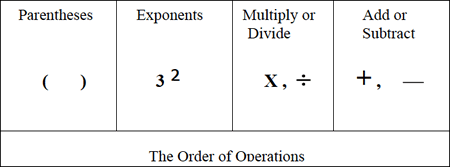Simplifying Expressions Using The Order of Operations
Main Core Tie
Mathematics Grade 5
Strand: OPERATIONS AND ALGEBRAIC THINKING (5.OA) Standard 5.OA.1
Additional Core Ties
Mathematics Grade 6
Strand: EXPRESSIONS AND EQUATIONS (6.EE) Standard 6.EE.2
Summary
Students will simplify numerical expressions using the correct order of operations
Materials
Attachments
- Paper for Foldables
- Graphing Calculators
- Team Boards or Smart Pals(boards, markers and wipe-off rag or eraser for each team)
- Order of Operations song (attached)
- Worksheets: Order of Operations Problem Solving, Order of Operations Practice
Background for Teachers
Enduring Understanding
(Big Ideas):
Operations
must be done in order
Essential Questions:
- What is the correct order for performing mathematical operations?
- How can expressions be written to indicate an order for operations?
- How does changing the order of operations affect the outcome when simplifying an expression?
Skill Focus:
Simplifying expressions
using the order of
operations
Vocabulary Focus:
Numerical expression, operation, order of operations, simplify
Ways to Gain/Maintain Attention (Primacy):
technology, music/rhythm/rhyme,
cooperative work, movement, writing, journal
Instructional Procedures
Attachments
Starter (launch):
Write five things you did to get ready for school today in the order you did those
things. Describe how would your morning would have been different if you had done
those things in a different order?
Lesson Segment 1: What is the correct order for performing mathematical
operations? How does changing the order of operations affect the outcome
when simplifying an expression?
Have students do Mix-Freeze-Pair where they walk around the room until you say,
"Freeze". Students find a partner closest to them (or raise their hand high to indicate
they need a partner, and move to someone else whose hand is raised). Have them
introduce themselves to their partner, then share with their partner the five things they
did to get ready for school and how their morning would be different if the order of
those things were changed. Then have students return to their seats.
Order does matter in many things. Give teams 3 minutes to make a list of anything they can think of in which order does matter. The team with greatest number of ideas wins, and reads their list. A person from each of the other teams reads one item from their list that hasn't been mentioned yet.
When performing math operations order matters.
Q. What is a math operation? Refer to the word on the board.
Write this expression on the board: 3² + 12/3 * (4 + 6). Ask students to simplify
mentally and give responses for their answer. (The correct value is 49). After hearing
their responses, tell them the correct response. Tell students the correct order of
operations, and simplify the expression to show them.
Help students sing "The Order Of Operations War" (attached).
Lesson Segment 2: Journal
Have students fold a paper horizontally so that about an inch is left over to fold up like
an envelop flap. Have them cut the shorter side into four equal flaps, then fold the
inch over the top of the four flaps like this:

Under the first flap write the expression you wrote on the board, 3² + 12/3 * (4 + 6).
As well as these other two expressions:
(5 + 9) |
and | 30 − 10 x 2 + 6 ÷ 3 |
| 4² − 9 |
For each express, perform and record the next step in simplifying under the appropriate flap, rewriting the expression each time to reflect the simplifying. Then, have the students write First, simplify parentheses, next simplify exponents, etc. under the appropriate flap. The foldable can be kept in a journal pocket
Lesson Segment 3: How can expressions be written to indicate an order for
operations? How does changing the order of operations affect the outcome
when simplifying an expression?
Using TI-73, work through and discuss the Order of Operations Problem Solving
(attached) and assign practice (attached), or use appropriate practice from text. I use
McDougal Littell's "One Left Out" from their Special Activities Resource Book, page 11.
Help students use calculator and appropriate notation to check
Practice: Play Krypto Extreme Game:
Players: Partners play against another pair
Objective: Use all five randomly generated integers to get answers from 1-10.
Procedure: Partners use TI-73's to generate a set of 5 integers from 1-10. Using the
order of operations, they work to use each of the 5 positive integers to get each of
these answers: 1, 2, 3, 4, 5, 6, 7, 8, 9, 10. To do this, they set up a problem to try to
get an answer of 1. If while they are working to get the 1, they get a 4 or a 9 etc
instead, they write the work they've done to get that number. The object is to use
each of their 5 random numbers to get every answer from 1-10. They earn a point for
each answer they are able to get from 1-10.
More Practice: You may want to choose text problems which include negative integers, fractions and decimals. Students should be constantly working with various forms of rational numbers in Pre-Algebra.
Closure: For the journal, have students do #1 on the Choice Board (attached), then choose one other square to complete.
Assessment Plan
performance tasks, observation
Bibliography
This lesson plan was created by Linda Bolin.
Updated: 02/05/2018


 UTAH EDUCATION NETWORK
UTAH EDUCATION NETWORK

 Justin
Justin Braxton
Braxton Dani
Dani Kayla
Kayla Katie
Katie Matthew
Matthew Rob
Rob Val
Val
